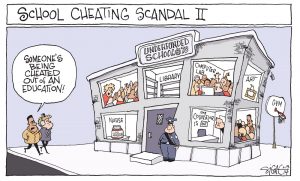This page addresses grassroots organizations that target inner city youth and how they provide support for access to higher education. A list of 10 grassroots working with urban areas are listed in the drop down menu above.
Who is involved?
Grassroots organizations involved in higher education access for inner city public education are composed of educators (most of whom are from the community), community leaders, college counselors, students, parents, and non-profit employees. The initial involvement starts with the partnership between schools and the community based organizations. From the students’ side, the involvement spans to their families, community leaders, then the community itself. From the school’s perspective, the involvement spans to teachers, school administrators, then district wide.
What is their message?
All these grassroots organizations emphasize an importance for urban public school students’ access to limited resources, an extensive networking and mentorship group, and scholarships to afford college. Resources provided include SAT tutoring, books,  scholarship money, transportation costs to and from school, and health insurance. By providing these resources, these grassroots organizations are acknowledging and alleviating the economic disadvantages that many of these low-income communities and their underfunded public schools need. These organizations also acknowledge the limited access to extensive networks for a post graduate professional life, and thus connect these students to program alumni or partner corporation/companies to hire these students after college. Finally, community involvement is emphasized in these mission statements, encouraging students to participate in their community and exercise their political influence. All in all, these organizations convey a message that addresses the economic, social, and political disparity between low-income, first generation urban students and the average American citizen.
scholarship money, transportation costs to and from school, and health insurance. By providing these resources, these grassroots organizations are acknowledging and alleviating the economic disadvantages that many of these low-income communities and their underfunded public schools need. These organizations also acknowledge the limited access to extensive networks for a post graduate professional life, and thus connect these students to program alumni or partner corporation/companies to hire these students after college. Finally, community involvement is emphasized in these mission statements, encouraging students to participate in their community and exercise their political influence. All in all, these organizations convey a message that addresses the economic, social, and political disparity between low-income, first generation urban students and the average American citizen.
How has their work affected their topic?
These grassroots organizations have provided a platform for urban public school students to reach their potential of accessing higher education and advocated for these students and their communities. They acknowledge the long term, large scale, issue, which includes the economic, social, and political inequalities in public urban education. This would be done through policy and social change (i.e., health insurance for all, free higher education, etc). Although there is much work to be done in that regard, they have empowered their students by providing them with a smoother pathway to college, professional networking, and involvement in their respective communities. In the meantime, they have also offered “bandage solutions” to alleviate these issues through non-profit approaches, which includes scholarships for high achieving individuals and emergency funds for families.
What are the challenges they are facing?
Many of these grassroots organizations depend heavily on donations and funding to function and expand accessibility to more students. As a large portion of the issues that urban public schools face are attributed to a lack of resources, these organizations also act as financial support systems, providing specific needs that each community needs. They also face the long term fight to help urban public schools become more equitable, which includes family involvement and community organizing to push for policy change. These fights face the barriers of politics on the local, state, and federal level, all while dealing with a rigid bureaucracy in the advocacy for change.
